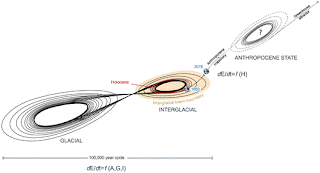Atmospheric CO2 Passed Important Threshold

The Earth just reached a CO2 level not seen in 3 million years The last time Earth had comparable levels of atmospheric carbon dioxide was about three million years ago, during the mid-Pliocene. Back then, global average temperature was about 3.6–5.2°F (2–3°C ) warmer than it is today. Sea levels were also higher, by about 15–25 meters. And while passing 400 parts per million permanently — or hitting a high of 410 parts per million, as happened on Tuesday — won’t trigger any immediate climate consequences, it is a stark reminder of the profound influence human activity is having on the planet. That's sea levels higher by 50 to 80 feet. And a 3 degree Celsius increase doesn't sound like much but it means a very different planet than we are now experiencing. The Keeling Curve. CREDIT: Scripps Institute of Oceanography Certainly now we are undergoing some droughts, floods, and extreme weather, and s ome social breakdown . But at 3 degrees Celsius we can expect far mo

